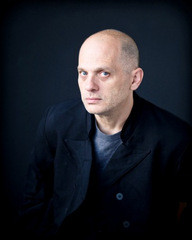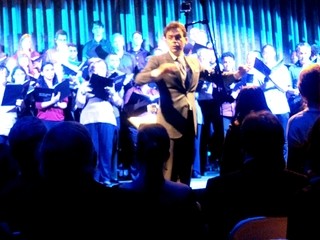|
Back
David Lang’s Amorphous Orisons New York
Intrepid Sea, Air & Space Museum
05/15/2014 -
David Lang: battle hymns (New York Premiere)
Brendan Ko (Drummer), Ariana Gibb, Chloe Roe, Melinda Orengo (“I’ll be a soldier” soloists), Jennifer Ribiero Melissa Kelley, Elizabeth Smith (Sopranos), Andrew Fuchs, Alex Guerrero, John Kawa, Kannan Vasudevan, Steven Moore (Tenors)
The Collegiate Chorale, Manhattan Girls Chorus, Michelle Oesterle (Artistic Director) Members of the Veteran Artist Program, James Bagwell (Conductor)
Ted Sperling (Director), Edward Barnes (Producer), Lindsey Turteltaub (Stage Manager), Al Natola@Frost Productions (Lighting)

D. Lang (© P. Serling)
Audiences here have experienced many a Mass these last ten days (Rowley, Britten, Cipullo, Bruckner), but when composer David Lang has his own tribute to the dead or dying or–in battle hymns–those facing death–one must listen. Mr. Lang may be known as one of the most eclectic of composers, but at his best, his originality, his understanding of audience feeling, and his mastery of vocal sentiments must be experienced.
Last night, his battle hymns, originally commissioned by the Leah Stein Dance Company, and Mendelssohn Club of Philadelphia, was performed in a large auditorium on board the Intrepid Sea, Air & Space Museum, an aircraft carrier in the Hudson River. The venue was singular, and as always, so was Mr. Lang’s inspired offering.

J. Bagwell, Collegiate Chorale (© Coco. T. Dog)
A composer of deep poetic sensibilities, Mr. Lang might have deserved a better structure for battle hymns than he had last night. Nothing was wrong with the space-conscious conducting of James Bagwell, who took advantage of the area acoustics in this auditorium. Nor were the various choirs and soloists anything but splendid.
The problem was that I assume Mr. Lang was looking for a certain fluidity, an organic relationship between the five sections of the 50-minute-long work. The poetry involved was partly cryptic, it did not give “directions”, it was expository rather than ideological. But a composer of Mr. Lang’s sensibility was not ready to give a five-act drama. This was a single work, and it turned out to be five short works.
The first movement ended, the audience applauded roundly. Lights went out after the second longest movement, the audience applauded, took sips of bottled water, lights went on and we continued with the third act.
The program notes stated that battle hymn has been previously produced as both staged and concert versions. I presume the staged version would be tied together in one uninterruptable work. In this concert version, we heard a quintet of choral works, all with the David Lang brand, but nothing to bring them to a coalescence.
Still, the quintet had some ravishing moments at the beginning and end., At the start, a young girl from behind us in the vast stretches of the room, sung the line from Stephen Foster, “I’ll be a soldier.” Now the hidden voices of the Manhattan Girls Chorus began chanting and singing in mesmeric, canonical, harmonized fashion the same line over and over again. Almost robot-like they advanced to the stage with those same words, while the full Collegiate Chorus–dressed in street clothes–offered their own phrases, “when the night shadows come”, “till the din of battle’s gone”. But they are far below, almost unheard over the girls...the children...perhaps the doomed ones.
For at the end, a sole voice continues From “I’ll be a soldier...” to...”And I’ll be far away.” Mr. Lang knew the doom of Foster’s simple words.
Lights off, children back off, and now a smaller chorus of the Collegiate Chorale sung what English professors might call the “deconstructed” version of a letter written home by a Civil War soldier before his death.
The letter was made famous in Ken Burns’ Civil War documentary, but Mr. Lang rearranged the feelings of the letter, making the statements alphabetical (“My very dear Sarah”, “Never forget”). Yet even with the usual clarity of the Collegiate Chorale, it was difficult to make out the phrases , save when the soloists came out of the crowd. Otherwise the lines tumbled out of each other, blurring themselves, in a seemingly eternal sing-song recitation which, frankly left me as cold as impressed.
More Stephen Foster, from the original “Tell me weary soldier from the rude and stirring wars, as my brother in the battle where you gained those noble scars?” That was written in 1862, when the Union was losing, but Foster (who never lived in the South) made the feelings universal. Mr. Lang used the words “Tell me” over and over again, a litany equivalent to a religious prayer asking the Lord to give comfort, where no comfort is to be given.”
I was personally most disturbed by the fourth section, Lincoln’s line (used also by Aaron Copland), “As I would not be a slave so I would not be a master.” Again, the repetitions of the line rolled out from the chorus, accompanied by a snare-drum player, Brendan Ko, walking through the audience with his solemn tattoos.
Yet one must ask whether this was blatant overkill. We don’t know Lincoln’s voice, but his words were so well chosen, his words so apt, so perfect, that they need no repetition, no parsing. They speak for themselves.
Some in the audience might have been enraptured by this endless repetition. I found it maddening that these 14 words, so consummate in themselves, needed to be gilded and re-gilded over and over again.
Perhaps this is became David Lang in battle hymns had more to do with the art (not the sentiment or belief) or religion than with composition. Words themselves–whether Latin or Kabbalistic Hebrew or Sufi poetry or Native American prayers–are devoid of meaning, where emotion is sucked out of the phrases, driving one into a universe where semantics and logic are secondary to the lulling of the priest or magician or shaman or imam.
Whatever hesitation I felt for these three sections, the end (like the end of Christopher Rowley’s recent Mass) gave way to a beautifully dramatic finish. In both works, it was the children who brought back the purity. Or in this case the lovely Manhattan Girls Chorus, again coming through the aisles onto the stage, slower and slower, repeating the Foster words from “Beautiful Dreamer”, turning each syllable into its own meaning. The chorus, in the meantime, under a turquoise light, is subdued, perhaps cowed, perhaps surrendering to the purity of the female voices, relegated to repeat, slower and slower, “Beautiful...beauty...” over and over again.
I do conceive of a performance without breaks, without applause, where each section somehow segues into the other, where that effect would be embracing, where our own moments of silence would adhere to the last notes of the choirs. But that didn’t happen. Instead, we had a round of applause for conductor Bagwell, for the composer, for the brilliant artistic director of the Manhattan Girls Chorus, Michelle Oesterele, and the show was over.
Doubts still remain whether Mr. Lang was more interested in the meaning or the semantics or the challenge. Doubts still remain whether this work could have adhered to itself the way these voices adhered to the words, building them, constructing them, giving voice to those sounds.
The swirls of sound, the protractions of words had the marks of a great composer. At times, though, I felt that Mr. Lang was de– and re-constructing words and music as if his own ideas were merely part of his canvas, both tenebrous and elegiac.
Harry Rolnick
|